
Hiking Around Las Vegas, Death Valley National Park, Death Valley Wilderness Area

 Grotto Canyon Road at Hwy 190 (view S) |
Overview This adventuresome hike, scramble, and climb runs up in the Death Valley Wilderness Area and Grotto Canyon, passing a series of obstacles that start out hard and seem to just keep getting higher and harder. The grottos and narrows are spectacular, the rock is water polished, the route finding is challenging, and the rock climbing is scary. This isn't a good place to hike alone, but it is a good place to bring a rope to belay or help team members get up the pour-overs. Among Death Valley hikers, there has been an attempt to maintain the "thrill of discovery" in this canyon. I will continue this tradition to some extent, but the canyon is so good that other well-prepared hikers should be encouraged to give it a try. There are no cairns past the first grotto -- let's keep it that way. Link to topographic map or elevation profile. |
 Trailhead parking at barricade behind jeep (view S) |
Watch Out Other than the standard warnings about hiking in the desert, ... this hike is pretty tough with lots of rock climbing, scrambling up steep places, and exposure when bypassing pour-overs. Much of the climbing is moderate 5th class, so bring a rope or webbing for belays. Falling at most pour-overs shouldn't be too bad because of soft sand and gravel in the landing zone, but it would be easy to twist an ankle or knee. Be mindful of thunderstorms, as this canyon is regularly swept by flashfloods. While hiking, please respect the land and the other people out there, and try to Leave No Trace of your passage. Also, this hike is in a wild and remote area, so be sure to bring the 10 Essentials. |
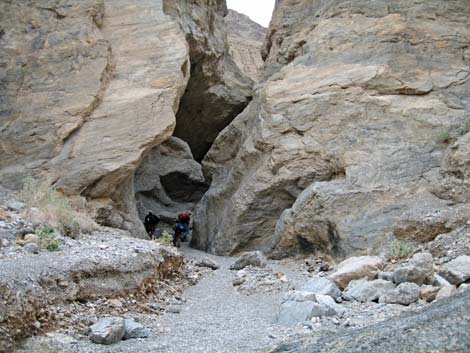 Entering the first grotto (view SE) |
Getting to the Trailhead This hike is located in Death Valley National Park, about 2.5 hours northwest of Las Vegas. From town, drive out to Death Valley. From the Furnace Creek Visitor Center (Table 1, Site 712), drive north and west on Highway 190 towards Stovepipe Wells (Site 751). Near the east end of the Sand Dunes parking area (2.4 miles before getting to Stovepipe Wells), turn left onto a narrow dirt road (Site 989) running south towards the mouth of a prominent canyon on Tucki Mountain. Continue up the road for 0.95 miles to where it drops off a bank and into Grotto Wash (Site 990). In a 2WD vehicle, stop here and walk up the wash; in a 4WD vehicle, drive into the wash and continue upstream through lots of loose gravel for another 0.86 miles to a barricade that marks the end of the road (Site 991). Park here; this is the trailhead. |
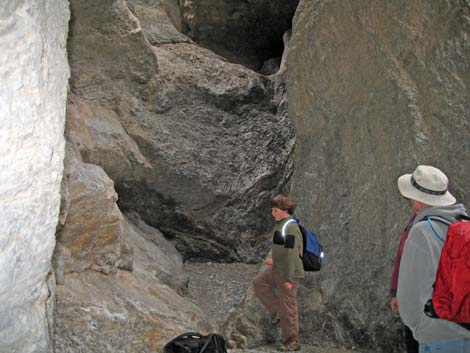 First serious obstacle (inside the first grotto) |
The Hike From the trailhead (Table 2, Waypoint 1), the route runs south and up the main wash for about 0.17 miles to the first grotto. Shortly after entering the grotto, the first obstacle is encountered: a 12-ft high pour-over that can be climbed fairly easily using chimney techniques. This was high enough that we belayed young Ben. After climbing the first, the second obstacle is quickly encountered: an 8-ft high partially overhanging pour-over, followed by a few more steps of easy scrambling. We boosted people up, who then set a rope for the rest of the group. A pair of hikers passed us here. Displaying good teamwork, one boosted the other, then the first slid into a crack and gave the second a hand up. Even with a pile of stones on the ground, the step-up over the overhand is a bit too high for comfort. |
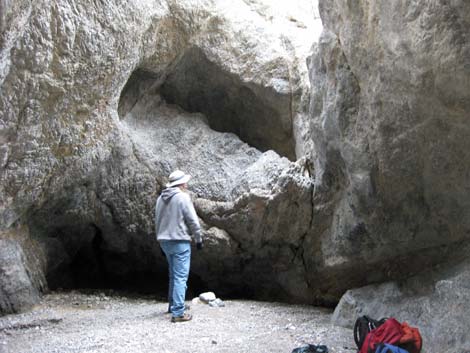 Second serious obstacle (inside the first grotto) |
Above the first grotto, the canyon opens up into a broad wash with vegetation along the sides. The entire canyon is in the Upper Sonoran Life Zone (Mojave Desert Scrub), but the wash is sparsely vegetated because of frequent scouring by flash floods. Keep an eye out for Netvein Goldeneye, Death Valley sage, and rock nettle. On the hillsides above the wash where plants can grow, look for creosote bush, white bursage, desert holly, and few other species. The rocks in this area are mostly Paleozoic sedimentary carbonates (i.e., limestone or dolomite) dating from about 490-290 million-years-ago. These layered rocks were laid down in an ocean, but we saw no fossils. However, the rocks record the amazing tilting, twisting, and folding that jumbled up this country. The wide canyon quickly narrows, and the canyon bottom becomes a series of little pour-overs that are easily climbed into the next grotto where the third serious obstacle is encountered: a fairly high, water polished slot that can be climbed using chimney techniques and a bit of trepidation. We belayed some of our team here. |
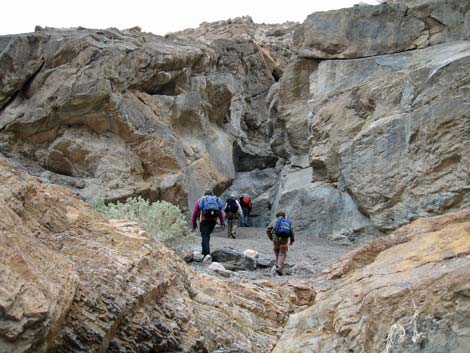 Little obstacles between serious obstacles |
Above this obstacle, the canyon opens a bit, but it is deep and narrow and has overhanging walls in some places. After winding through, easy passage ends at a high pour-over. My trip notes record 80-ft high, but it was probably only 40-feet. Regardless, passing this fourth obstacle requires a bypass route. Without endangering the "thrill of discovery," too much, we went a fair way down the canyon before starting on a bypass. After bypassing the high pour-over (Wpt. 5), we continued up the canyon clambering over small obstacles and winding along until we hit the fifth obstacle, a high wall of chockstones wedged between water-polished walls. It was raining hard by now, so we bailed and headed for home. On the way down, we saw what likely was the bypass for this obstacle, but with the wet rocks, we continued on down. |
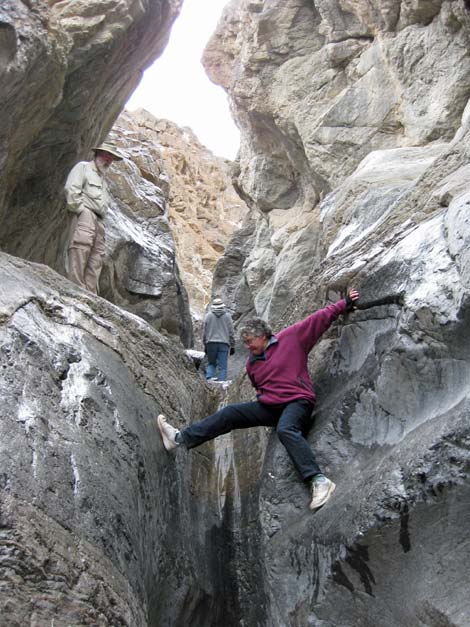 Third serious obstacle (second grotto) |
When daylight starts to run out or you hit your last serious obstacle, turn around and head back down the canyon. In contrast to most hikes, the hike down this canyon is the other half of the adventure (remember, pour-overs always look worse on the way down). By the way, next time remember to bring an extension ladder. |
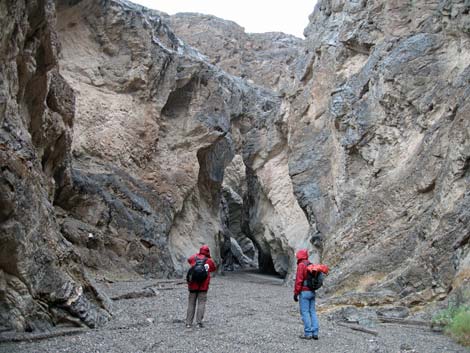 Narrows that end at an unclimbable 80-ft pour-over, 4th obstacle |
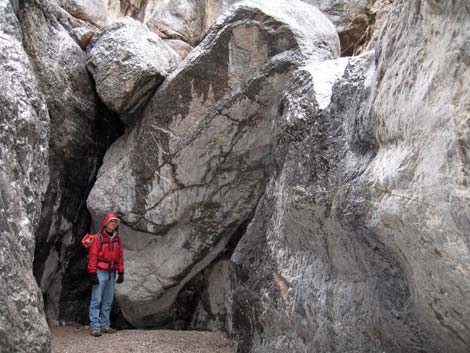 This chockstone, the fifth serious obstacle, ended our adventure |
Table 1. Highway Coordinates (NAD27; UTM Zone 11S). Download Highway GPS Waypoints (*.gpx) file.
| Site # | Location | Latitude (N) | Longitude (W) | Easting | Northing | Elevation (ft) | Verified |
|---|---|---|---|---|---|---|---|
| 0712 | Furnace Creek Visitor Center | 36.46159 | 116.86574 | 512030 | 4034954 | -186 | Yes |
| 0751 | Hwy 190 at Stovepipe Wells | 36.60654 | 117.14594 | 486948 | 4051034 | 0 | Yes |
| 0989 | Hwy 190 at Grotto Canyon Rd | 36.60438 | 117.10484 | 490623 | 4050789 | 12 | GPS |
| 0990 | Grotto Canyon Rd at 2WD Parking | 36.59153 | 117.10961 | 490195 | 4049364 | 448 | GPS |
| 0991 | Grotto Canyon Rd at 4WD Parking | 36.58222 | 117.10297 | 490788 | 4048331 | 752 | GPS |
Table 2. Hiking Coordinates Based on GPS Data (NAD27; UTM Zone 11S). Download Hiking GPS Waypoints (*.gpx) file.
| Wpt. | Location | UTM Easting | UTM Northing | Elevation (ft) | Point-to-Point Distance (mi) | Cumulative Distance (mi) |
|---|---|---|---|---|---|---|
| 01 | Trailhead | 490788 | 4048331 | 752 | 0.00 | 0.00 |
| 02 | Above First Obstruction | 490907 | 4048056 | 896 | 0.23 | 0.23 |
| 03 | Second Narrows | 490935 | 4047726 | 995 | 0.26 | 0.49 |
| 04 | Wide Spot in Canyon | 491000 | 4047690 | 1,069 | 0.04 | 0.53 |
| 05 | Top of High Pour-Over | 491076 | 4047614 | 1,152 | 0.08 | 0.61 |
| 06 | End of Our Route | 490979 | 4047209 | 1,382 | 0.35 | 0.96 |
| 01 | Trailhead | 490788 | 4048331 | 752 | 0.96 | 1.92 |
Happy Hiking! All distances, elevations, and other facts are approximate.
![]() ; Last updated 241022
; Last updated 241022
| Death Valley | Hiking Around Las Vegas | Glossary | Copyright, Conditions, Disclaimer | Home |